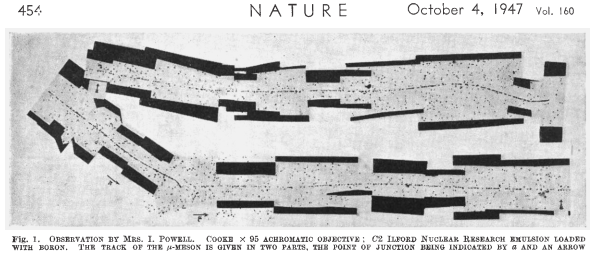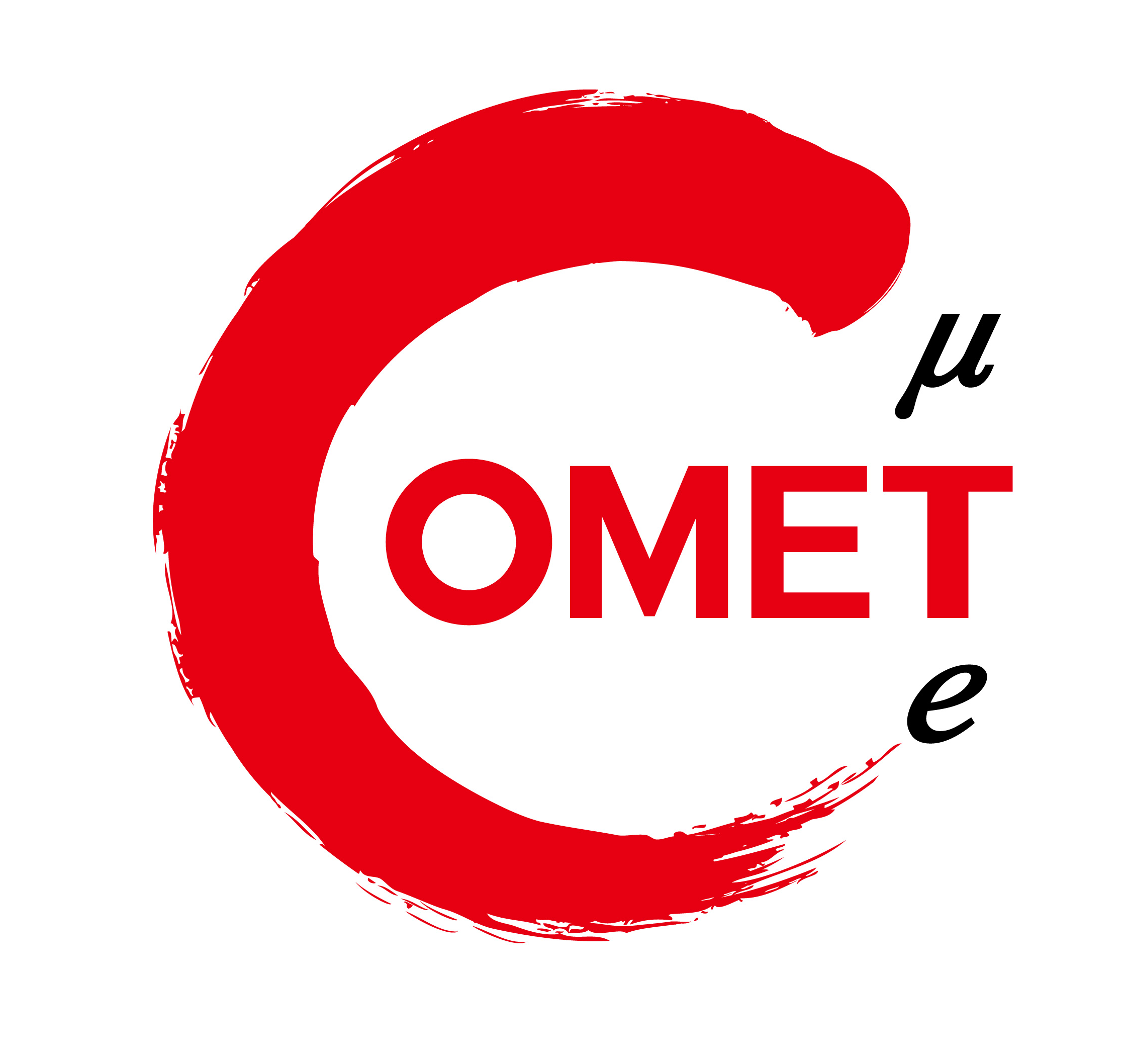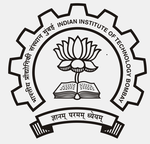Semiconductor Research and Development
My area of expertise is developing semiconductor detectors for particle physics and other applications.
BIG NEWS!
Our latest work on TiO2 was published in IEEE Sensors on January 1, 2023. Oh happy New Year!
 The first experimental discoveries of subatomic particles were made in the 1940's like the iconic discovery of a Pi meson
decaying to a mu-lepton in an emulsion detector image shown here.
We have gone through over 70 years of developing ever more complex
theories explaining the properties of these particles and their interactions.
Alongside, this has required the building of extremely sophisticated detectors to measure their experimental
properties.
The first experimental discoveries of subatomic particles were made in the 1940's like the iconic discovery of a Pi meson
decaying to a mu-lepton in an emulsion detector image shown here.
We have gone through over 70 years of developing ever more complex
theories explaining the properties of these particles and their interactions.
Alongside, this has required the building of extremely sophisticated detectors to measure their experimental
properties.
In the last few decades solid-state detectors made of semiconducting materials have taken over the task of detecting nearly all forms of radiation. This spans the vast range from visible light in the ubiquitous digital camera through UV light in solar cells to relativistic charged particles produced in collisions of high energy fundamental particles.
The focus of my research lab is to develop semiconductor detectors at IIT Bombay. We are setup with most of the cleanroom equipment to fabricate and characterize novel types of semiconductor detector structures. In recent years, we have been working primarily on wide bandgap semiconductors that have enormous potential advantages over the traditionally used silicon based devices.
COMET at J-PARC: Coherent Muon to Electron Tansition at the Japanese Proton Accelerator Research Center
The standard model forbids the direct conversion of muons to electrons, as this would violate
the priniciple of lepton number conservation. However, since neutrinos have been observed to
oscillate between flavors, the search for charged lepton flavor violation promises a new
window into physics beyond the standard model.
 The COMET
experiment will look for such rare muon to electron conversions.
Muons provide the best laboratory to study lepton flavor violation as they can be produced in
substantial numbers and have a sufficiently long lifetime for precise measurements of their decays.
Present accelerators can produce about 1015 muons/year. A new high intensity source
at the J-PARC main proton synchrotron ring will produce more than 1018 muons/year.
The COMET
experiment will look for such rare muon to electron conversions.
Muons provide the best laboratory to study lepton flavor violation as they can be produced in
substantial numbers and have a sufficiently long lifetime for precise measurements of their decays.
Present accelerators can produce about 1015 muons/year. A new high intensity source
at the J-PARC main proton synchrotron ring will produce more than 1018 muons/year.
The main processes are the decays μ → eγ, μ→ eee and
μ-→ e - conversion. Of these,
μ-→ e -
conversion has the best sensitivity to new physics, as the potentially measurable branching ratio of about
10-16 is significantly better than the limits expected with current technology for the
μ → eγ and μ→ eee processes.
Our role in the experiment is to build a beam monitor for the particle beams that would be subject to
the most intense radiation ever tested in experiments.
Collaborators: Prof. Kantimay Dasgupta, Prof. Subhabrata Dhar (IIT Bombay), Prof. Satoshi Mihara, Prof. Hajime Nishiguchi (KEK, Japan)
CMS experiment at the Large Hadron Collider (LHC), CERN
In the past (2014 - 2019) I collaborated on the CMS experiment at Large Hadron Collider (LHC).
The LHC is designed to produce collisions between
ultra-relativistic fundamental particles (protons on protons) or
lead ions on lead ions. Proton-proton collisions are expected to verify
all the detailed calculations of the Standard Model, and more excitingly
discover many new things predicted by theory that have not yet been found
at lower energies.
 My primary interest in LHC physics is to study the properties of small volumes
of extremely high energy density
created in the collisions of heavy ions that mimic conditions which must have
existed soon after the Big Bang in the evolution of the Universe.
Theoretical calculations predict that the very high matter density and temperature
reached during the collision will cause a phase transition from 'ordinary' matter to
a deconfined plasma of elementary quarks and gluons.
My primary interest in LHC physics is to study the properties of small volumes
of extremely high energy density
created in the collisions of heavy ions that mimic conditions which must have
existed soon after the Big Bang in the evolution of the Universe.
Theoretical calculations predict that the very high matter density and temperature
reached during the collision will cause a phase transition from 'ordinary' matter to
a deconfined plasma of elementary quarks and gluons.
CMS
Compact Muon
Solenoid experiment at LHC has unique capabilities
among the experiments at LHC in studying particles out to very large
values of transverse momentum. In numerical terms this roughly correspnds to
kicking two footballs so that they collide head on, split into approximately
10,000 individual bits ejected perpendicular to their original trajectory.
Studying the properties of all the 10,000 bits lets us reconstruct the details of
what happened in the collision.
Currently our group's studies are focused on the properties of jets produced
in heavy ion collisions.
Collaborators: Dr. Ajit Mohanty (BARC group)
Gravitational Wave Detection with LIGO experiment
In the past (2003-2009), I have worked on the LIGO experiment.
(Laser
Interferometric
Gravitational wave Observatory)
Gravitational waves are ripples in the structure of space-time caused by the movement
of massive stellar objects - much like waves on the surface of water created by an object
dropped in.
 The emission of gravitational waves has been a long-standing prediction of Einstein's
General Theory of Relativity that has never been directly verified. LIGO
is an ambitious experiment to make a direct measurement using the interefernce of laser beams
travelling in perpendicular directions under carefully controlled conditions. Besides being a marvel
of innovation beyond-the-bleeding edge technology in of itself, the detection of gravitational
waves in LIGO would throw open a whole knew window to the Universe. In all of scientific history, we
have viewed the Universe through some form of electromagnetic radiation. Gravity waves would reveal
an entirely new facet never seen before.
The emission of gravitational waves has been a long-standing prediction of Einstein's
General Theory of Relativity that has never been directly verified. LIGO
is an ambitious experiment to make a direct measurement using the interefernce of laser beams
travelling in perpendicular directions under carefully controlled conditions. Besides being a marvel
of innovation beyond-the-bleeding edge technology in of itself, the detection of gravitational
waves in LIGO would throw open a whole knew window to the Universe. In all of scientific history, we
have viewed the Universe through some form of electromagnetic radiation. Gravity waves would reveal
an entirely new facet never seen before.
Though I'm not currently an active member of the LIGO experiment, I continue to collaborate with
past colleagues on specific technology oriented projects.
Education
I see research and teaching as a continuous spectrum of academic endeavor. Some of my best ideas have come from 'a-ha' moments while interacting with students in class or working together on a project. IIT Bombay's program on Education Technology formally adresses the issues surrounding teacher student interaction.
Research Philosopy
This page lays out my approach to doing scientific research.
Publications
The tedious task of keeping an up-to-date list has been outsourced to Google Scholar
At present NO short term project opportunities are available in my group.

Contact:
Department of Physics,
IIT Bombay
Powai, Mumbai 400 076
Tel: +91-22-25767591
Fax: +91-22-25767552
Email: pradeepsarin[at]iitb ...
My calendar